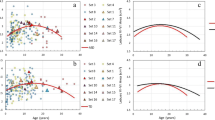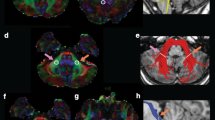Abstract
This study examined patterns of cerebellar volumetric gray matter (GM) loss across the adult lifespan in a large cross-sectional sample. Four hundred and seventy-nine healthy participants (age range: 7–86 years) were drawn from the Brain Resource International Database who provided T1-weighted MRI scans. The spatially unbiased infratentorial template (SUIT) toolbox in SPM8 was used for normalisation of the cerebellum structures. Global volumetric and voxel-based morphometry analyses were performed to evaluate age-associated trends and gender-specific age-patterns. Global cerebellar GM shows a cross-sectional reduction with advancing age of 2.5 % per decade—approximately half the rate seen in the whole brain. The male cerebellum is larger with a lower percentage of GM, however, after controlling for total brain volume, no gender difference was detected. Analysis of age-related changes in GM volume revealed large bilateral clusters involving the vermis and cerebellar crus where regional loss occurred at nearly twice the average cerebellar rate. No gender-specific patterns were detected. These data confirm that regionally specific GM loss occurs in the cerebellum with age, and form a solid base for further investigation to find functional correlates for this global and focal loss.







Similar content being viewed by others
References
Grieve SM et al. Regional heterogeneity in limbic maturational changes: evidence from integrating cortical thickness, volumetric and diffusion tensor imaging measures. NeuroImage. 2011;55(3):868–79.
Tamnes CK et al. Brain maturation in adolescence and young adulthood: regional age-related changes in cortical thickness and white matter volume and microstructure. Cereb Cortex. 2010;20(3):534–48.
Sowell ER, Thompson PM, Toga AW. Mapping changes in the human cortex throughout the span of life. Neuroscientist. 2004;10(4):372–92.
Grieve SM et al. Preservation of limbic and paralimbic structures in aging. Hum Brain Mapp. 2005;25(4):391–401.
Paul R et al. Relative contributions of the cerebellar vermis and prefrontal lobe volumes on cognitive function across the adult lifespan. Neurobiol Aging. 2009;30(3):457–65.
O’Hare ED et al. Mapping cerebellar vermal morphology and cognitive correlates in prenatal alcohol exposure. Neuroreport. 2005;16(12):1285–90.
Sullivan EV et al. Cerebellar volume decline in normal aging, alcoholism, and Korsakoff’s syndrome: relation to ataxia. Neuropsychology. 2000;14(3):341–52.
Grieve SM et al. Widespread reductions in gray matter volume in depression. NeuroImage Clin. 2013;3:332–9.
Joyal CC et al. MRI volumetry of the vermis and the cerebellar hemispheres in men with schizophrenia. Psychiatry Res. 2004;131(2):115–24.
Okugawa G, Sedvall GC, Agartz I. Smaller cerebellar vermis but not hemisphere volumes in patients with chronic schizophrenia. Am J Psychiatry. 2003;160(9):1614–7.
Schmitt JE et al. Enlarged cerebellar vermis in Williams syndrome. J Psychiatr Res. 2001;35(4):225–9.
Hagemann G et al. Cerebellar volumes in newly diagnosed and chronic epilepsy. J Neurol. 2002;249(12):1651–8.
Pinter JD et al. Neuroanatomy of Down’s syndrome: a high-resolution MRI study. Am J Psychiatry. 2001;158(10):1659–65.
Galluzzi S et al. Aging. Neurol Sci. 2008;29(3):296–300.
Chung SC et al. Effects of age, gender, and weight on the cerebellar volume of Korean people. Brain Res. 2005;1042(2):233–5.
16. Ellis, 1920.
Koller WC et al. Cerebellar atrophy demonstrated by computed tomography. Neurology. 1981;31(4):405–12.
Luft AR et al. Patterns of age-related shrinkage in cerebellum and brainstem observed in vivo using three-dimensional MRI volumetry. Cereb Cortex. 1999;9(7):712–21.
Oguro H et al. Sex differences in morphology of the brain stem and cerebellum with normal ageing. Neuroradiology. 1998;40(12):788–92.
Raz N et al. Differential effects of age and sex on the cerebellar hemispheres and the vermis: a prospective MR study. AJNR Am J Neuroradiol. 1998;19(1):65–71.
Raz N et al. Age and sex differences in the cerebellum and the ventral pons: a prospective MR study of healthy adults. AJNR Am J Neuroradiol. 2001;22(6):1161–7.
Raz N et al. Differential age-related changes in the regional metencephalic volumes in humans: a 5-year follow-up. Neurosci Lett. 2003;349(3):163–6.
Szabo CA et al. MR imaging volumetry of subcortical structures and cerebellar hemispheres in normal persons. AJNR Am J Neuroradiol. 2003;24(4):644–7.
Torvik A, Torp S, Lindboe CF. Atrophy of the cerebellar vermis in ageing. A morphometric and histologic study. J Neurol Sci. 1986;76(2-3):283–94.
Xu J et al. Gender effects on age-related changes in brain structure. AJNR Am J Neuroradiol. 2000;21(1):112–8.
Taki Y et al. Correlations among brain gray matter volumes, age, gender, and hemisphere in healthy individuals. PLoS ONE. 2011;6(7):e22734.
Andersen BB, Gundersen HJ, Pakkenberg B. Aging of the human cerebellum: a stereological study. J Comp Neurol. 2003;466(3):356–65.
Ashburner J, Friston KJ. Nonlinear spatial normalization using basis functions. Hum Brain Mapp. 1999;7(4):254–66.
Salmond CH et al. Distributional assumptions in voxel-based morphometry. Neuroimage. 2002;17(2):1027–30.
Tisserand DJ et al. Regional frontal cortical volumes decrease differentially in aging: an MRI study to compare volumetric approaches and voxel-based morphometry. Neuroimage. 2002;17(2):657–69.
Dimitrova A et al. MRI atlas of the human cerebellar nuclei. NeuroImage. 2002;17(1):240–55.
Dimitrova A et al. Probabilistic 3D MRI atlas of the human cerebellar dentate/interposed nuclei. Neuroimage. 2006;30(1):12–25.
Magnotta VA et al. Subcortical, cerebellar, and magnetic resonance based consistent brain image registration. Neuroimage. 2003;19(2 Pt 1):233–45.
Jernigan TL et al. Effects of age on tissues and regions of the cerebrum and cerebellum. Neurobiol Aging. 2001;22(4):581–94.
Hickie IB et al. Development of a simple screening tool for common mental disorders in general practice. Med J Aust. 2001;175(Suppl):S10–7.
Diedrichsen J et al. Imaging the deep cerebellar nuclei: a probabilistic atlas and normalization procedure. NeuroImage. 2011;54(3):1786–94.
Rajapakse JC, Giedd JN, Rapoport JL. Statistical approach to segmentation of single-channel cerebral MR images. Med Imaging IEEE Trans. 1997;16(2):176–86.
Ashburner J. A fast diffeomorphic image registration algorithm. NeuroImage. 2007;38(1):95–113.
Beg MF et al. Computing large deformation metric mappings via geodesic flows of diffeomorphisms. Int J Comput Vis. 2005;61(2):139–57.
Schmahmann JD et al. Three-dimensional MRI atlas of the human cerebellum in proportional stereotaxic space. Neuroimage. 1999;10(3 Pt 1):233–60.
Thach WT, Goodkin HP, Keating JG. The cerebellum and the adaptive coordination of movement. Annu Rev Neurosci. 1992;15:403–42.
Bower JM. Control of sensory data acquisition. Int Rev Neurobiol. 1997;41:489–513.
Ivry R. Cerebellar timing systems. Int Rev Neurobiol. 1997;41:555–73.
Akshoomoff NA, Courchesne E, Townsend J. Attention coordination and anticipatory control. Int Rev Neurobiol. 1997;41:575–98.
Cabeza R, Nyberg L. Imaging cognition II: an empirical review of 275 PET and fMRI studies. J Cogn Neurosci. 2000;12(1):1–47.
Hutchinson S et al. Cerebellar volume of musicians. Cereb Cortex. 2003;13(9):943–9.
Lemieux L, Liu RS, Duncan JS. Hippocampal and cerebellar volumetry in serially acquired MRI volume scans. Magn Reson Imaging. 2000;18(8):1027–33.
Nopoulos P et al. Sexual dimorphism in the human brain: evaluation of tissue volume, tissue composition and surface anatomy using magnetic resonance imaging. Psychiatry Res. 2000;98(1):1–13.
Larsen JO, Skalicky M, Viidik A. Does long-term physical exercise counteract age-related Purkinje cell loss? A stereological study of rat cerebellum. J Comp Neurol. 2000;428(2):213–22.
Torvik A, Torp S, Lindboe CF. Atrophy of the cerebellar vermis in ageing. Journal of the neurological sciences. 1986;76(2):283–94.
Deshmukh AR et al. Quantification of cerebellar structures with MRI. Psychiatry Res Neuroimaging. 1997;75(3):159–71.
Escalona PR et al. In vivo stereological assessment of human cerebellar volume: effects of gender and age. AJNR Am J Neuroradiol. 1991;12(5):927.
Buckner RL et al. The organization of the human cerebellum estimated by intrinsic functional connectivity. J Neurophysiol. 2011;106(5):2322–45.
Acknowledgments
We acknowledge the data and support provided by BRAINnet; www.BRAINnet.net, under the governance of the BRAINnet Foundation. BRAINnet is the scientific network that coordinates access to the Brain Resource International Database for independent scientific purposes. We also thank the individuals who gave their time to participate in the database. The staff at the Department of Radiology, Westmead Hospital, Sydney and at Wakefield Imaging, Adelaide are thanked for their support. We gratefully acknowledge the contribution of Prof Richard Clark for overseeing the data collection at the Adelaide site. MSK is supported by the Australian National Health & Medical Research Council Career Development Fellowship (APP1090148) and Project Grant (APP1008080). SMG acknowledges the support of the Sydney Medical School Foundation and the Parker Hughes Bequest, University of Sydney.
Author information
Authors and Affiliations
Corresponding author
Ethics declarations
Conflicts of Interest
The authors declare that they have no conflicts of interest.
Rights and permissions
About this article
Cite this article
Yu, T., Korgaonkar, M.S. & Grieve, S.M. Gray Matter Atrophy in the Cerebellum—Evidence of Increased Vulnerability of the Crus and Vermis with Advancing Age. Cerebellum 16, 388–397 (2017). https://doi.org/10.1007/s12311-016-0813-x
Published:
Issue Date:
DOI: https://doi.org/10.1007/s12311-016-0813-x




